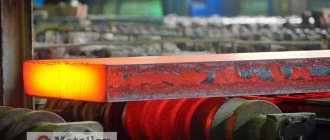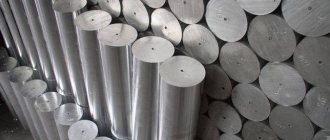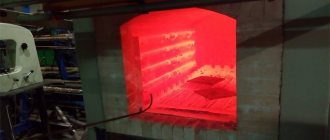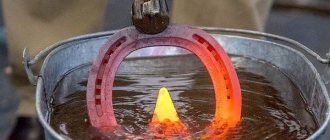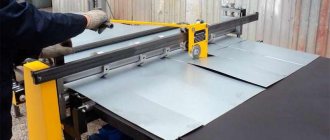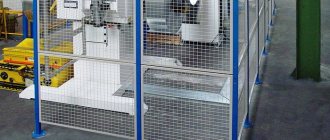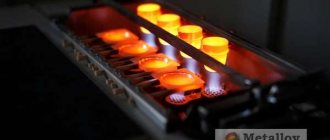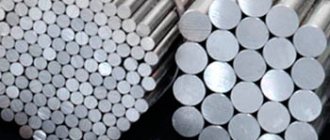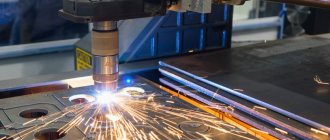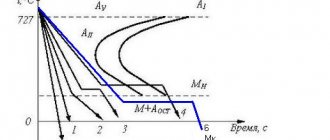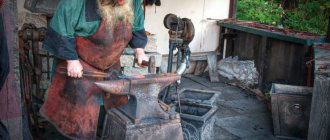Types of annealing
The essence of the process is to heat the metal product and then slowly cool it. As a result, the viscosity index improves and chemical and structural homogeneity is achieved. Heat treatment by annealing has a negative effect on the hardness of steel.
Depending on the required qualities of the product, the following types of annealing are performed:
- Diffusion. The purpose of processing is to reduce the chemical heterogeneity of the composition. First, the steel is heated to a temperature of +1150°C and the workpiece remains in this state for 10-15 hours. Then slow (natural) cooling is performed.
- Full. It is performed for stamping products or blanks made by casting or forging. The goal is to form a fine-grained structure. The steel is heated to a temperature exceeding the critical upper point by +50°C. Then slow cooling occurs at a rate of no more than 75°C (for alloyed grades) or +200°C (for carbon grades) per hour.
- Incomplete annealing. Heat treatment is used to reduce stiffness and relieve structural stress. The technology is similar to that described above, with the exception of the maximum temperature value. It should not exceed +750°C.
- Isothermal. It is relevant only for alloy steels. The exposure temperature is 20-30% higher than the critical point. Differences from full annealing are rapid cooling to +600°C. The technique is used for rapid processing of steel workpieces.
To perform these procedures, special equipment is required. The quality of processing depends on the requirements being met. If the technology is not followed, there is a high probability of defects – burnout.
Heat treatment: hardening, tempering, normalization, annealing
Metal products used in any sector of the economy must meet wear resistance requirements. For this purpose, exposure to high temperatures is used, as a result of which the desired performance properties are enhanced. This process is called heat treatment.
Heat treatment is a set of operations of heating, cooling and holding metal hard alloys to obtain the required properties by changing the structure and internal structure. Heat treatment is used as an intermediate operation in order to improve machinability by cutting, pressure, or as the final operation of the technological process, which provides the required level of properties of the part.
Various hardening methods have been used for a long time: craftsmen immersed a heated metal strip in wine, oil, or water. For cooling, blacksmiths sometimes used quite interesting methods, for example, they mounted a horse and raced, cooling the product in the air.
Depending on the method of implementation, heat treatment can be of the following types:
-Thermal (normalization, hardening, tempering, annealing, aging, cryogenic treatment).
-Thermo-mechanical. Involves processing at high temperatures in combination with mechanical stress on the alloy.
-Chemical-thermal. It involves heat treatment of metal followed by enrichment of the surface of the product with chemical elements (carbon, nitrogen, chromium, etc.).
Main types of heat treatment:
1. Hardening . It is a type of heat treatment of various materials (metals, glass), consisting of heating them above a critical temperature with rapid subsequent cooling. Performed to obtain nonequilibrium structures with an increased cooling rate. Hardening can be either with a polymorphic transformation or without a polymorphic transformation.
2. Tempering is a technological process, the essence of which is the heat treatment of a metal or alloy hardened to martensite, the main processes in which are the decomposition of martensite, recrystallization and polygonization. It is carried out with the aim of relieving internal stresses and giving the material the necessary operational and mechanical properties.
3. Normalization. In this case, the product is heated to an austenitic state and then cooled in still air. As a result of normalization, internal stresses are reduced and steel recrystallizes. Compared to annealing, normalization is a shorter and more productive process.
4. Annealing . It is a heat treatment operation consisting of heating steel, holding it at a given temperature and then slowly cooling it along with the furnace. As a result of annealing, a stable structure is formed, free from residual stresses. Annealing is one of the most important mass heat treatment operations of steel.
Annealing purpose:
1) Reducing hardness and increasing ductility to facilitate metal cutting;
2) Reduction of internal stress arising after pressure treatment (forging, stamping), machining, etc.;
3) Removing brittleness and increasing impact resistance;
4) Elimination of structural heterogeneity in the composition of the material that occurs during solidification of the casting as a result of segregation.
For non-ferrous alloys (aluminum, copper, titanium), heat treatment is also widely used. Non-ferrous alloys are subjected to both softening and strengthening heat treatment, depending on the required properties and scope of application.
Heat treatment of metals and alloys is the main technological process in ferrous and non-ferrous metallurgy. At the moment, technical specialists have at their disposal many heat treatment methods that allow them to achieve the desired properties of each type of processed alloys. Each metal has its own critical temperature, which means that heat treatment must be carried out taking into account the structural and physicochemical characteristics of the substance. Ultimately, this will allow not only to achieve the desired results, but also to significantly streamline production processes.
Hardening
The technique is relevant for creating an uneven structure in a steel workpiece. This increases hardness, but also increases the fragility of the structure. The choice of exposure temperature depends on the chemical composition. Also important are the cooling rate and frequency of repetition of the procedure.
When choosing a hardening technology, the following factors are taken into account:
- Processing temperature. If it does not exceed the critical value, the hardening is classified as incomplete. To process the entire structure of the workpiece, the thermal effect must be 30-40° above the Acz point.
- Cooling. It can be done quickly or slowly. In the first case, the hardness is uneven, closer to the surface. With slow cooling, the stress of the structure is equalized.
- Selection of quenching medium. Most often, a salt bath or oil with the addition of special substances is used.
- Periodicity. It affects the distribution of rigidity in the steel structure.
Hardening methods are calculated individually for each type of product. Read about how to harden and temper metal at home here.
Heat treatment of non-ferrous metals
Alloys based on other metals do not respond to hardening as well as steel, but their hardness can also be increased by heat treatment. Typically a combination of hardening and pre-annealing (heating above the phase transformation point with slow cooling) is used.
- Bronzes (copper alloys) are annealed at a temperature just below the melting point, and then quenched with water cooling. Quenching temperature from 750 to 950C depending on the composition of the alloy. Tempering at 200-400C is carried out for 2-4 hours. The highest hardness values, up to HV300 (about HRC 34), can be obtained for products made of beryllium bronze.
- The hardness of silver can be increased by annealing to a temperature close to the melting point (dull red color) and then quenching.
- Various nickel alloys are annealed at 700-1185C, such a wide range is determined by the variety of their compositions. For cooling, salt solutions are used, particles of which are then removed with water or protective gases that prevent oxidation (dry nitrogen, dry hydrogen).
| Metal | Annealing temperature, C° | Cooling medium |
| Copper Brass L96 Brass L90-L62 Cupronickel Nickel silver Silver Aluminum Duralumin | 500 — 600 540 — 600 600 — 700 650 — 700 700 — 750 650 — 700 300 — 350 360 — 380 | Water Outdoor Outdoor Water Water Water Outdoor Oven Cooling |
Vacation
To normalize the characteristics of steel workpieces after hardening, it is recommended to temper it. Its essence lies in thermal exposure to temperatures at which phase transformation does not occur. The result of this operation will be the homogeneity of the steel structure.
Types of tempering for metal blanks:
- Short. Used for carbon steel grades. The maximum exposure temperature is +200°C. As a result, the fragility index decreases and the tension in the structure decreases.
- Average. Heat treatment occurs at +400°C. Technology is needed to remove excess carbon. In this case, the crystal lattice becomes cubic.
- High. Processing temperature – up to +650°С. It is used to achieve optimal characteristics of strength, viscosity and ductility.
The defining indicator for this process is temper brittleness. It indicates the degree to which impact strength drops during sudden temperature changes.
Classification and types of heat treatment
The fundamental parameters affecting the quality of heat treatment are:
- heating time (speed);
- heating temperature;
- duration of holding at a given temperature;
- cooling time (intensity).
By changing these modes, you can obtain several types of heat treatment.
Types of heat treatment of steel:
- Annealing
- I – kind:
- homogenization;
- recrystallization;
- isothermal;
- removal of internal and residual stresses;
- Hardening;
- Vacation:
- short;
- average;
- high.
- Normalization.
Heating temperature of steel during heat treatment
Vacation
Tempering in mechanical engineering is used to reduce the strength of internal stresses that appear during hardening. High hardness makes products brittle, so tempering is used to increase impact strength and reduce the hardness and brittleness of steel.
Vacation low
Low tempering is characterized by the internal structure of martensite, which, without reducing hardness, increases viscosity. Measuring and cutting tools are subjected to this heat treatment. Processing modes:
- Heating to a temperature of 150°C, but not higher than 250°C;
- holding time - one and a half hours;
- cooling - air, oil.
Average holiday
For medium tempering, transformation of martensite into trostite. Hardness decreases to 400 HB. Viscosity increases. Parts that operate under significant elastic loads are subjected to this tempering. Processing modes:
- heating to a temperature of 340°C, but not higher than 500°C;
- cooling - air.
High holiday
With high tempering, sorbitol crystallizes, which eliminates stress in the crystal lattice. Critical parts are manufactured that have strength, ductility, and toughness.
Heating to a temperature of 450°C, but not higher than 650°C.
Annealing
The use of annealing makes it possible to obtain a homogeneous internal structure without stress on the crystal lattice. The process is carried out in the following sequence:
- heating to a temperature slightly above the critical point, depending on the grade of steel;
- holding with constant temperature maintenance;
- slow cooling (usually cooling occurs together with the furnace).
Homogenization
Homogenization, otherwise known as diffusion annealing, restores the non-uniform segregation of castings. Processing modes:
- heating to a temperature from 1000°C, but not higher than 1150°C;
- exposure – 8-15 hours;
- cooling:
- oven – up to 8 hours, temperature reduction to 800°C;
- air.
Recrystallization
Recrystallization, otherwise low annealing, is used after plastic deformation treatment, which causes hardening by changing the grain shape (hardening). Processing modes:
- heating to a temperature above the crystallization point by 100°C-200°C;
- holding – ½ – 2 hours;
- cooling is slow.
Isothermal annealing
Alloy steels are subjected to isothermal annealing to cause austenite decomposition. Heat treatment modes:
- heating to a temperature of 20°C - 30°C above the point;
- holding;
- cooling:
- fast - not lower than 630°C;
- slow – at positive temperatures.
Stress Relief Annealing
Removal of internal and residual stresses by annealing is used after welding, casting, and machining. With the application of work loads, parts are subject to destruction. Processing modes:
- heating to a temperature of – 727°C;
- holding - up to 20 hours at a temperature of 600°C - 700°C;
- cooling is slow.
Complete annealing
Full annealing makes it possible to obtain an internal structure with fine grains, which contains ferrite and pearlite. Full annealing is used for cast, forged and stamped workpieces, which will subsequently be processed by cutting and subjected to hardening.
Complete annealing of steel
- heating temperature – 30°C-50°C above point ;
- excerpt;
- cooling to 500°C:
- carbon steel – temperature decrease per hour is no more than 150°C;
- alloy steel – temperature decrease per hour is no more than 50°C.
Partial annealing
With incomplete annealing, lamellar or coarse pearlite is transformed into a ferrite-cementite grain structure, which is necessary for welds produced by electric arc welding, as well as tool steels and steel parts subjected to processing methods whose temperature does not provoke grain growth of the internal structure.
- heating to a temperature above the point or, above 700°C by 40°C - 50°C;
- curing - about 20 hours;
- cooling is slow.
Hardening
Hardening of steels is used for:
- Promotions:
- hardness;
- strength;
- wear resistance;
- elastic limit;
- Reductions:
- plasticity;
- shear modulus;
- compression limit.
The essence of hardening is the fastest cooling of a thoroughly heated part in various environments. Heating is performed with and without polymorphic changes. Polymorphic changes are possible only in those steels that contain elements capable of transformation.
Such an alloy is heated to a temperature at which the crystal lattice of the polymorphic element undergoes changes, due to which the solubility of alloying materials increases. As the temperature decreases, the lattice changes structure due to an excess of alloying element and takes on a needle-like structure.
The impossibility of polymorphic changes during heating is due to the limited solubility of one component in another at a rapid cooling rate. There is little time for diffusion. The result is a solution with an excess of undissolved component (metastable).
To increase the cooling rate of steel, the following media are used:
- water;
- water-based brine solutions;
- technical oil;
- inert gases.
Read also: Checking the performance of the Schottky diode sr56ked
Comparing the rate of cooling of steel products in air, cooling in water from 600°C occurs six times faster, and from 200°C in oil 28 times faster. Dissolved salts increase the hardening ability. The disadvantage of using water is the appearance of cracks in places where martensite forms. Industrial oil is used to harden alloy alloys, but it sticks to the surface.
Metals used in the manufacture of medical products should not have a film of oxides, so cooling occurs in an environment of rarefied air.
To completely get rid of austenite, which causes high brittleness in steel, products are subjected to additional cooling at temperatures from -40°C to -100°C in a special chamber. You can also use carbonic acid mixed with acetone. This processing increases the accuracy of parts, their hardness, and magnetic properties.
If parts do not require volumetric heat treatment, only the surface layer is heated using HDF (high-frequency current) installations. In this case, the depth of heat treatment ranges from 1 mm to 10 mm, and cooling occurs in air. As a result, the surface layer becomes wear-resistant, and the middle is viscous.
The hardening process involves heating and holding steel products at temperatures reaching about 900°C. At this temperature, steels with a carbon content of up to 0.7% have a martensite structure, which, during subsequent heat treatment, will transform into the required structure with the appearance of the desired qualities.
Normalization
Normalization produces a fine grain structure. For low-carbon steels this is a ferrite-pearlite structure, for alloyed steels it is a sorbitol-like structure. The resulting hardness does not exceed 300 HB. Hot-rolled steels are subjected to normalization. At the same time, they increase:
- fracture resistance;
- processing performance;
- strength;
- viscosity.
Steel normalization process
- heating occurs to a temperature of 30°C-50°C above the point ;
- maintaining in a given temperature range;
- cooling - in the open air.
Normalization of metal blanks
The technology is similar to steel annealing. The difference lies in the method of cooling the workpiece. This does not happen in the oven, as in the first case, but in the air. As a result, the structure of the crystal lattice is normalized, and strength and toughness indicators increase.
When performing this process, the following indicators are taken into account:
- Excerpt. It characterizes the degree of uniform thermal impact on all layers of the steel billet.
- Cooling rate. Affects the thickness of pearlite plates.
- Staged cooling. In some cases, after reaching a certain level of temperature reduction, the part is placed in oil for rapid cooling.
To achieve the desired properties of a steel billet, several types of heat treatment can be performed.
